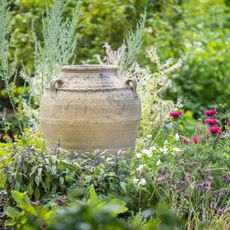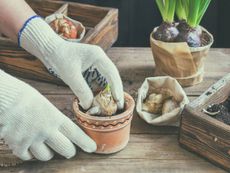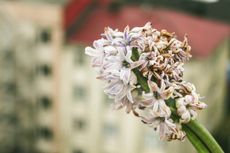Indoor Hyacinth Care: Caring For Hyacinth Houseplants Post Flowering


Due to their attractive flowers and delicious smell, potted hyacinths are a popular gift. Once they’re done blooming, though, don’t rush to throw them away. With a little care, you can keep your indoor hyacinth after blooming to ensure many more fragrant blossoms in the future. Keep reading to learn more about hyacinth care indoors after blooming.
Hyacinth Care Indoors After Flowering
After 8 to 12 weeks of blooming, your hyacinth will begin to go dormant. First the flowers will die, and eventually the leaves will wither. When most of the flowers are brown, cut the entire flower stalk off. This is called deadheading. The foliage will still be green at this point, and should be left to die off naturally.
Be careful not to break or bend the leaves, as this can prevent the plant from storing up much needed energy for its next blooming cycle. Feed your plant with a good indoor plant fertilizer to build up even more of this energy. Don’t overwater, though. Hyacinth bulbs are prone to bulb rot if watered too vigorously.
What to Do With Indoor Hyacinth After Blooming
Eventually, the leaves will wither and brown. This isn’t your fault - it’s just the plant’s natural cycle. Once the leaves are dead, cut the entire plant back to soil level, so only bulb and roots remain. Move your pot to a cold, dark space. You may even want to put a paper grocery or black garbage bag over the pot to keep out the light.
Don’t touch your hyacinth until the spring. At that point, begin to expose it gradually to light, and it should begin to send up new shoots. Hyacinths propagate by sending up daughter shoots, meaning your plant will take up more and more space each year. If your pot seemed just big enough last year, move the plant, while it’s still dormant, into a bigger pot, or plant it outside in your garden to give it more room to grow.
Gardening tips, videos, info and more delivered right to your inbox!
Sign up for the Gardening Know How newsletter today and receive a free download of our most popular eBook "How to Grow Delicious Tomatoes."

The only child of a horticulturist and an English teacher, Liz Baessler was destined to become a gardening editor. She has been with Gardening Know how since 2015, and a Senior Editor since 2020. She holds a BA in English from Brandeis University and an MA in English from the University of Geneva, Switzerland. After years of gardening in containers and community garden plots, she finally has a backyard of her own, which she is systematically filling with vegetables and flowers.
-
 Front Yard Herb Garden Ideas To Spice Up Your Landscape
Front Yard Herb Garden Ideas To Spice Up Your LandscapeUse your imagination and plant a lovely front yard herb garden. You’ll love the convenience, the fragrance and the beauty, and pollinators will appreciate it.
By Amy Grant
-
 When To Clean Up Garden Beds In Spring To Protect Pollinators
When To Clean Up Garden Beds In Spring To Protect PollinatorsEvery spring, I'm reminded that many species of insects have used my garden as a winter hotel and may not be ready for a wake-up call just yet.
By Teo Spengler
-
 Hyacinth Bulb Itch – What To Do For Hyacinth Skin Allergy
Hyacinth Bulb Itch – What To Do For Hyacinth Skin AllergyHyacinth is a popular fall planted bulb for cheerful, fragrant spring blooms. These flowers help to drive away winter glooms. Unfortunately, hyacinth irritation can be an issue. Learn more about this skin problem, referred to as hyacinth bulb itch, in the following article.
By Mary Ellen Ellis
-
 Growing Amethyst Hyacinths: Information On Amethyst Hyacinth Plants
Growing Amethyst Hyacinths: Information On Amethyst Hyacinth PlantsGrowing Amethyst hyacinths (Hyacinthus orientalis ‘Amethyst’) couldn’t be much easier and, once planted, each bulb produces one spiky, sweet-smelling, pinkish-violet bloom every spring, along with seven or eight big, shiny leaves. Learn more in this article.
By Mary H. Dyer
-
 Hyacinth Seed Propagation – How To Grow Hyacinths From Seed
Hyacinth Seed Propagation – How To Grow Hyacinths From SeedAs hyacinth flowers fade and small green seed pods begin to form in their place, you may wonder, can you propagate hyacinth seeds? Click this article to learn about saving hyacinth seed and hyacinth seed propagation.
By Darcy Larum
-
 Curing Hyacinths: When To Dig Up Hyacinth Bulbs For Storing
Curing Hyacinths: When To Dig Up Hyacinth Bulbs For StoringIt's important not to dig up your hyacinth bulbs at the wrong time, or else your bulbs may not have enough energy to sprout. Learn about hyacinth bulb curing and storing hyacinth bulbs in the article that follows. Click here for more info.
By Liz Baessler
-
 Propagating Hyacinth Offsets – How To Propagate Bulbs Of Hyacinth
Propagating Hyacinth Offsets – How To Propagate Bulbs Of HyacinthAlthough most gardeners find it easier and faster to purchase hyacinth bulbs, hyacinth propagation by seeds or offset bulbs is easier than you may think. Want to learn more about propagating and growing hyacinth bulbs? Click here.
By Mary H. Dyer
-
 Container Grown Hyacinths: How To Plant Hyacinth Bulbs In Pots
Container Grown Hyacinths: How To Plant Hyacinth Bulbs In PotsHyacinths are famous for their pleasant fragrance. They also grow very well in pots, perfuming a patio, a walkway, or a room in your house. Learn how to plant hyacinth bulbs in pots in this article.
By Liz Baessler
-
 My Hyacinth Is Turning Brown – Caring For Browning Hyacinth Plants
My Hyacinth Is Turning Brown – Caring For Browning Hyacinth PlantsHyacinths make great indoor or outdoor plants and are harbingers of spring, but when they start turning brown, these cheery faces are suddenly a reason for panic. Find out if your hyacinth has a real problem or if it's just going through its normal lifecycle in this article.
By Kristi Waterworth
-
 Hyacinth Bud Drop: Why Hyacinth Buds Fall Off
Hyacinth Bud Drop: Why Hyacinth Buds Fall OffBud problems with hyacinth are rare but occasionally these spring bulbs fail to bloom. Finding out why hyacinth buds fall off or, worse, why they never formed buds in the first place, can take some sleuthing. This article will help.
By Bonnie L. Grant